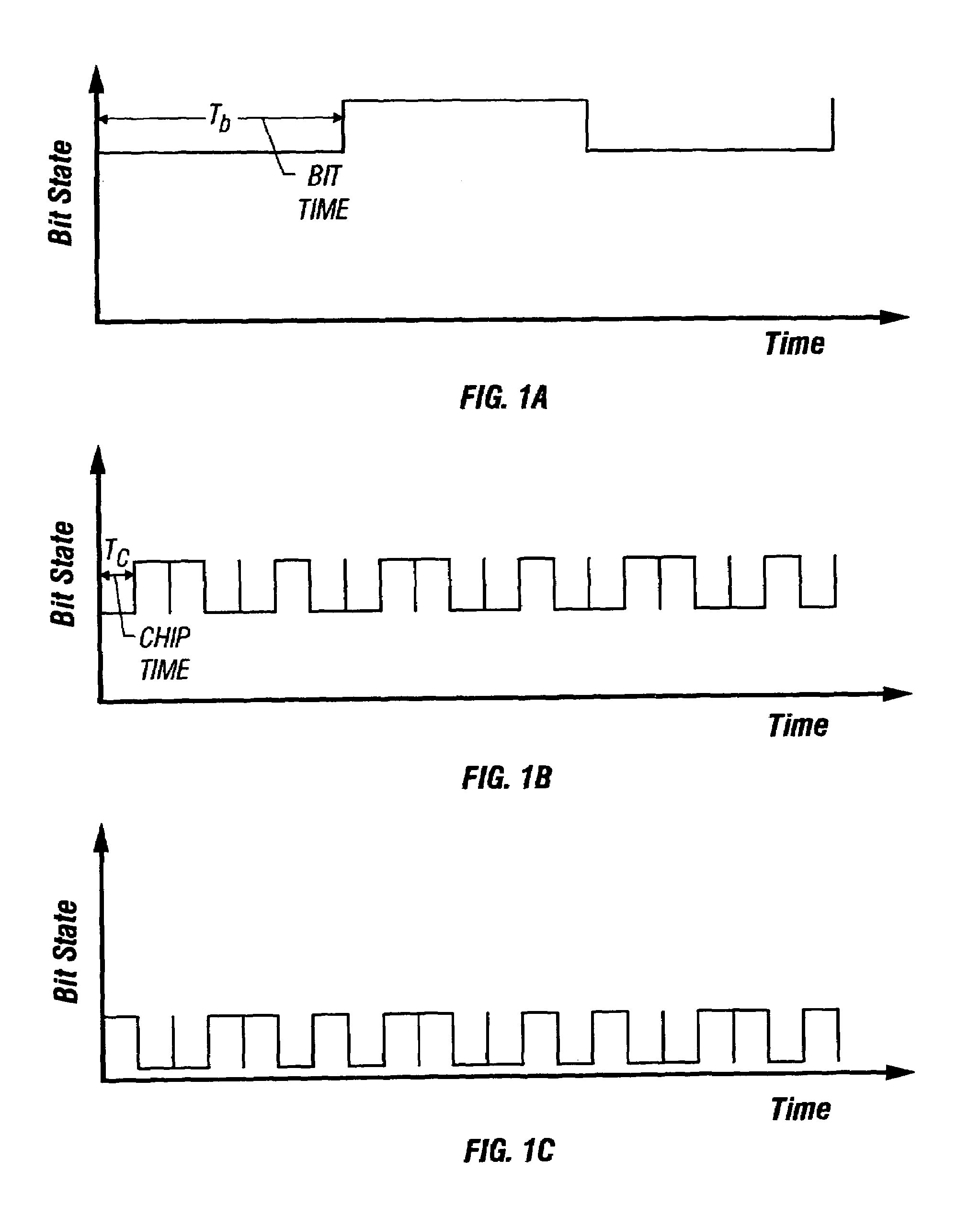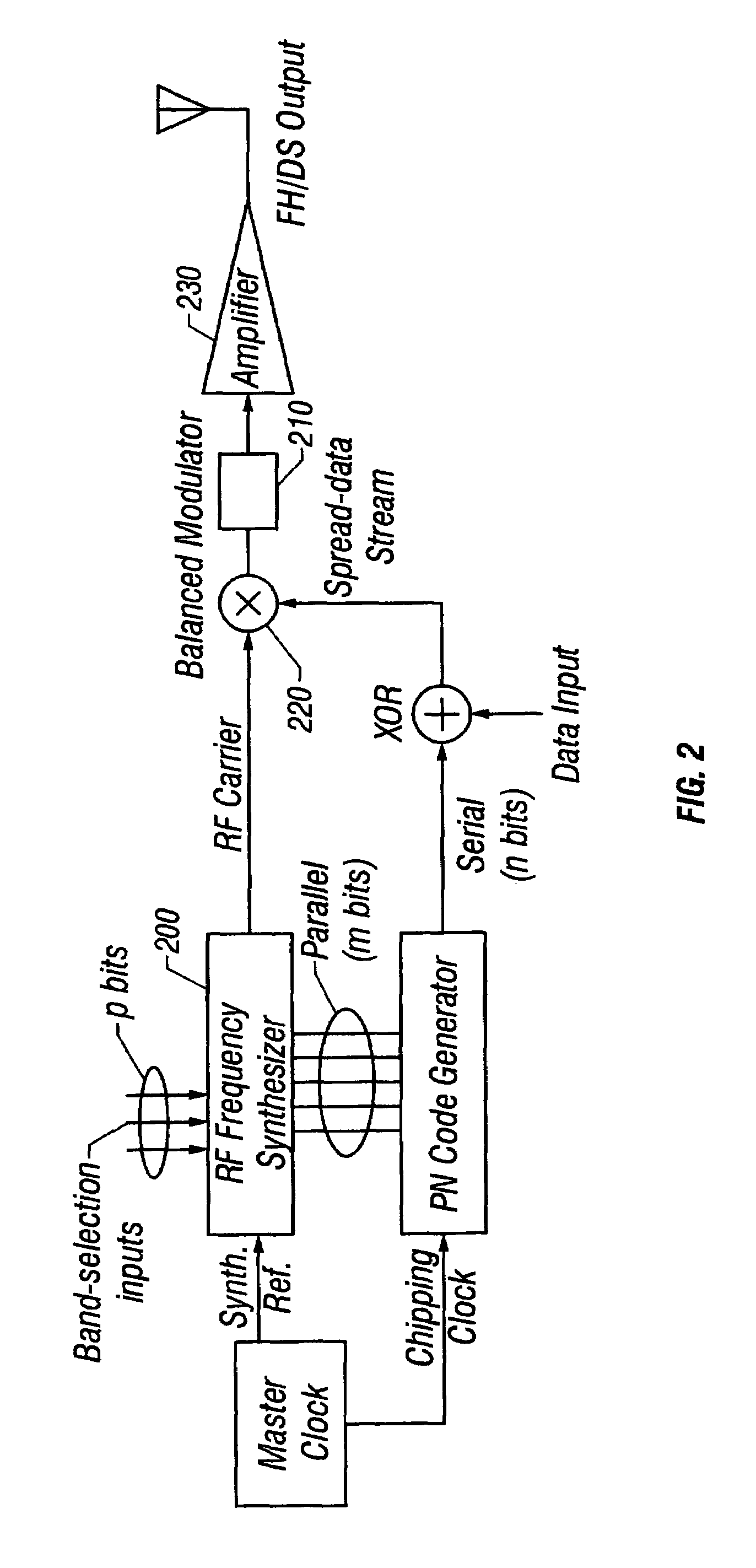Hybrid spread-spectrum technique for expanding channel capacity
a spread-spectrum and channel technology, applied in the field of communications, can solve the problems of user interference, increased reliability, and increased reliability of users, and achieve the effect of increasing the number of users
- Summary
- Abstract
- Description
- Claims
- Application Information
AI Technical Summary
Benefits of technology
Problems solved by technology
Method used
Image
Examples
example 1
[0062]Referring to FIGS. 2–3, a hybrid frequency-hopping / direct-sequence (FH / DS) spread-spectrum scheme is depicted.
[0063]The hybrid frequency-hopping / direct-sequence (FH / DS) spread-spectrum transmitter depicted in FIG. 2 is configured for standard BPSK data modulation. A subset of m bits from the full n-bit (n>m) PN code is used in synchronization with the chipping sequence to drive an RF synthesizer 200 to generate the exact RF carrier frequency desired for the hybrid SS transmission. Note that an additional p higher-order bits in the RF synthesizer word are used to specify the RF operating band; the lower-order m bits from the PN register select the individual hopping channels. An optional low-pass filter 210 can be located between a balanced modulator 220 and an amplifier 230.
[0064]The corresponding hybrid FH / DS spread-spectrum receiver architecture is shown in FIG. 3. Here, the incoming hybrid signal is amplified in a front-end low-noise amplifier (LNA) 300, down converted to t...
example 2
[0065]Referring to FIGS. 4–5, a hybrid time-hopping / direct-sequence (TH / DS) spread-spectrum scheme is depicted.
[0066]FIG. 4 details a hybrid time-hopping / direct-sequence (TH / DS) transmitter. Here, as in the previous FH / DS transmitting scheme, a main PN code generator 400 of n bits provides a subset of m bits to a pattern-detecting coincidence gate 410. When the selected m-bit pattern is recognized, a data gate 420 gates a burst of data bits into the DS spreader (via an exclusive-OR gate 430 feeding a balanced modulator 440. Simultaneously, a T flip-flop driven by the coincidence output line gates on a final RF power amplifier 450 to complete the time-hopped burst transmission process. An optional low pass filter 460 can be located between the balanced modulator 440 and an RF switch 470.
[0067]The corresponding TH / DS receiver depicted in FIG. 5 is similar to the FH / DS unit described in Example 1, except that the m bits extracted from a master PN generator 500 drive a coincidence detec...
example 3
[0068]FIGS. 6–7 depict hybrid FH / TH / DS transmitter and receiver block diagrams, respectively, which logically combine both FH / DS and TH / DS schemes to achieve more complex spreading distributions and afford even higher data security than the simpler types; the specific details can be the same as those in the previous examples.
PUM
 Login to View More
Login to View More Abstract
Description
Claims
Application Information
 Login to View More
Login to View More - R&D
- Intellectual Property
- Life Sciences
- Materials
- Tech Scout
- Unparalleled Data Quality
- Higher Quality Content
- 60% Fewer Hallucinations
Browse by: Latest US Patents, China's latest patents, Technical Efficacy Thesaurus, Application Domain, Technology Topic, Popular Technical Reports.
© 2025 PatSnap. All rights reserved.Legal|Privacy policy|Modern Slavery Act Transparency Statement|Sitemap|About US| Contact US: help@patsnap.com



